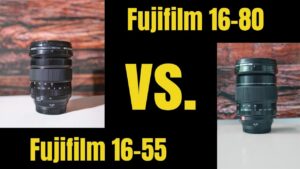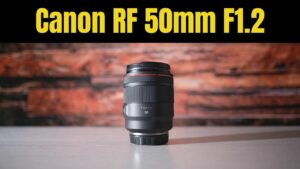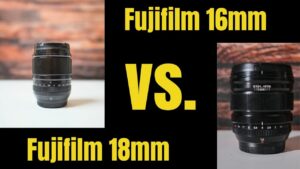Quick Facts about the Fujifilm XF 50-140mm F/2.8 R LM OIS WR Lens
- Weight: 2.19lbs/995 Grams
- Weather Sealed: Yes
- Filter Size: 72mm
- Angle of View: 31.7 to 11.6 Degrees
- Focusing Distance: 3.28’/1m
- Max Aperture: F2.8
- Minimum Aperture: F22
- Image Stabilization: Yes
- Mount System: Fuji X
- Price: $1,599
- Zoom: Internal
Quick Facts about the Fujifilm XF 70-300mm F4-5.6 R LM OIS WR Lens
- Weight: 1.3 lb/588 Grams
- Weather Sealed: Yes
- Filter Size: 67mm
- Angle of View: 22.9 to 5.4 Degrees
- Focusing Distance: 2.7’/.8 Meters
- Max Aperture: F4-F5.6
- Minimum Aperture: F22
- Image Stabilization: Yes
- Mount System: Fuji X
- Price: $799
- Zoom: Extension
- Accepts Teleconverters*
Table of Contents
Why compare the Fujifilm 50-140 vs the 70-300?

There are numerous reasons to compare the Fujifilm XF 70-300 and the Fujifilm XF 50-140.
First, despite 20mm on the shorter-end, both lenses cover identical focal lengths. (And a very popular focal length for portrait photographers as well.)
Second, besides the great, new 150-600mm lens, I firmly believe that these two lenses are the premier telephoto options for the X-Mount.
Third, and finally, you will occasionally be able to find used copies of the 50-140 for about the same price as a new XF 70-300.
So, let’s get into it.
Who are both of these lenses for?
Now, the 50-140 is a great and versatile focal length. (FF Equivalent is about 70-200)
In my personal experiences, I haven’t just used this focal length for portraits, but also wildlife, landscapes, and hand-held video! (This lens is big, but it’s not impossible to hand-hold videos!)
And the 70-300 is not a bad focal length. (100-450 FF Equivalent) That extra reach from 200-300mm allows for some bird and sport photography as well!
However, if you are doing events in low-light, I highly recommend the 50-140 over the 70-300 because of the aperture! (More on this below)
What other telephoto lenses exist within the Fuji-X lineup?
Zooms
Lately, I have been very impressed by Fujifilm’s ability to release high-quality zooms.
Now, that isn’t to say that their earlier models such as the 55-200 were not excellent. But more so to applaud the image sharpness of lenses like this 70-300 and the 150-600mm.
These lenses are sharp throughout the entire focal length vs some of the older models lost image quality as one zoomed throughout the focal range.
- Fujifilm XF 55-200 F3.5-4.8
- Fujifilm XC 50-230mm F4.5-6.7
- Fujifilm XF 100-400mm F4.5-5.6
- Fujifilm XF 150-600 F5.6-F8
Primes
The primes do have better image quality than 70-300, and they are much smaller. However, I would honestly debate if some of these primes are too much sharper than the 50-140. It’s a beast of a lens in regards to sharpness.
If you are looking at purchasing something such as the XT20 or XT30, please keep the size of the camera model relative to the lens in mind.
- Fujifilm XF 80mm F2.8
- Fujifilm XF 90mm F2.0
Build Quality Comparison

In regards to build quality, the 70-300 and 50-140 are both at the top of their classes. However, I need to make it apparent that they are built VERY differently.
The 50-140 has a premium price and premium feel with an all-metal construction, marked aperture ring, and a pleasant internal zoom experience. (That black paint does leave smudges.)
Meanwhile, the 70-300 is constructed out of high-quality plastics.
I am not considered about the durability or weather resistance of either of these lenses
Dials, Knobs, Switches, and Feet
Comparing the dials, knobs, and switches on these lenses, surprisingly, the 50-140 noticeably has less. It has one switch, the OIS-ON/OFF switch. And it does have the removable tripod foot.
Meanwhile, the 70-300 lacks the tripod foot, but does have a zoom-lock(!), the auto aperture switch, and the close focus limiter (5 Meter vs Full) switch.
For a tutorial on how to use these, please see the 100-400 Review.
How far is the FOV?
Now, the angle of view for the 70-300 is 22.9-5.4 Degrees.
The angle of view for the 55-200 is 31.7-11.6 Degrees.
Whenever I examine my personal photography style and its FOV, I tend to focus on street photography and landscapes. And the 50-70mm FOV is very valuable. (If anything, 70mm always feels like it’s just a bit too close.)
For example, look at the OIS portion of the review. You will see that I had to angle the lens away from the road to get an image.
So, if your style is similar to mine, I would recommend the 50-140. However, just to note, you aren’t going to be inconspicuous.
Fujfilm 50-140 vs 70-300 Sharpness Test
Look, the 70-300 is a great lens, and I was content about the output from it. However, the 50-140 is in a different class. At every focal length and aperture, the Fujifilm XF 50-140 was extremely sharp.
So, here are my takeaways from the brickwall photos above.
About the 70-300
- The corners seemed a *bit softer at 70mm @F4.
- The corners at 70mm @F8 and 300mm @F8 look similar in regards to image quality/sharpness
- This lens is very sharp throughout the entire focal range.
- I was never disappointed with the output of this lens. All around, I think I could trust everything that this was designed for. (Like travel photography.)
About the 50-140
- Starting at around F2,8, sharpness remains excellent throughout the entire zoom range. Kudos to Fujifilm for that.
- The 50-140 appeared weaker at the short-end rather than the longer end.
- The lens performs worst at F2.8…as expected.
Bokeh Test
In the 50-140 review, I called the bokeh “busy,” and I stand by those words. Look, F2.8 on a full-frame sensor does not provide the same depth of field as F2.8 on a crop-sensor camera.
Although some people find F4 on full-frame sensors a sweet-spot (Please don’t get mad at me. F2.8 on APS-C produces similar depth-of-field as F4 on Full-Frame… even though it lets in the same amount of light, etc. I know. I know)
But when it came to the bokeh on that 50-140, I was never pleased with the background. If I did not frame the subject perfectly, the background was distracting. Plus, the foliage was just too much.
Now, the 70-300 at 300mm F5.6 should theoretically be able to provide a shallower depth of field because of the extreme focal length. However, the transition from subject to background just felt more natural.
Now, it is not great that in order to get this type of image, we will have to raise the ISO. (For sports, the 50-140 should be your only option for the X-Mount beside the 200mm F2.)
However, it is what it is.
The Depth of Field Category goes to the 70-300.
Bokeh Balls Test
In regards to the bokeh balls, I would say both lenses perform about the same. At their maximum aperture, the corners suffer from cat’s eye. However, as you stop down, the bokeh balls slowly round out.
An advantage of the 50-140’s F2.8 is the bokeh balls round out very quickly AND the ability to use that F2.8 aperture. The 70-300 just cannot complete in low-light. (But it tries with the inclusion of the OIS…more on that below. )
Both lenses have linear motors for auto-focusing. However, I don’t know if it’s because of these linear motors, magnets, or what BUT the 50-140 does have a small rattle. The rattle is not nearly audible as the 33mm f1.4, but it is there….
Focusing Distance and Macro Performance
If you intend to use either of these lenses for macro-style photography, here are some of the things you should know.
First, the 70-300 is a better lens for macro photography. As seen in the figures, it has a higher reproduction ratio and a closer focusing distance.
Otherwise, there are two other options within the X-Mount more suited for macro-style work, the 60mm F2.4 and the 80mm F2.8.
The XF 80mm F2.8 has a reproduction ratio if 1:1.
70-300
The Fujifilm XF 70-300 has a focusing distance of 2.7 feet/.8 meter with a maximum reproduction ratio of .33x.
50-140
The Fujifilm XF 50-140 has a focusing distance of 3.28 feet/1 meter with a maximum reproduction ratio of .12x.
OIS Test
Despite over 5 years of changes in technology, the 70-300 only provides .5 a stop more of OIS than the 50-140. (I want my 10 stops!)
According to the specification sheet, the 70-300 offers up to 5.5 stops of Optical Image Stabilization, and the 50-140 provides up to 5 stops.
I think the inclusion of image stabilization in either the camera body or lens is almost necessary at the extreme telephoto lengths, and both of these lenses are no exception.
Now, I was able to get handheld video footage. I don’t know if it was “5 stops” worthy; however, it was usable.
(No post-production stabilization)
Starburst/Sunburst
The Fujifilm 50-140 provides a great experience in regards to the starburst effect.
I was able to achieve excellent, 14 point starbursts throughout the entire frame.
Now, the 70-300 provides a pleasant experience, but the starbursts are not nearly as prominent.
All around, if I had to compare the sunstars from each Fuji XF Lens, it would go
#1 50-140
#2 70-300
#3 55-200
#4 150-600
#5 100-400
Why should I pick the 50-140 over the 70-300?
- The F2.8 Aperture
Sure, the bokeh is not very great. However, that doesn’t affect the light gathering ability. If you are shooting any event-style photography, you will need the F2.8 for low-light.
- Pure Sharpness
Hands down, the 50-140 wins at image sharpness. You will be able to get a sharp and usable image at every aperture and focal length.
- City Photography
What if I told you, besides the 16mm F1.4, my second lens for street photography was a 900mm Full-Frame equivalent lens.
However, between these two lenses, if you plan on focusing on any city photography, you will need the 50-140.
A long time ago, I learned most buildings are built to the human-eye scale. This is why lenses beyond the 24mm (FF) length are seldom actually needed. So, for me, I know that most of my photos will be between 24mm and 70mm for street photography.
Plus, you can always crop from 50mm to 70mm with the 50-140.
Why should I pick the 70-300 over the 50-140
- Travel Photography
Look, there is no question that the 70-300 has a much longer focal length. However, if you are needing a lens for bird photography or wildlife, the only option should be the 70-300.
- Price
For the price of the 50-140, you would be able to purchase both the 70-300 (new) and a 90mm F2 (used).
That might be a preferred combination by most; however, that is just one more lens to juggle.
To each their own.
My Final Ratings
Fujifilm XF 50-140mm f2.8 R LM OIS WR
Fujifilm XF 70-300mm f4-5.6 R LM OIS WR
Price: 2.5/5
Photography isn’t a cheap hobby, and I think the price is excessive. I could purchase the 70-300 AND a prime lens for the cost of this.
Reliability: 4/5
Paired with the X-T4 or X-T3, it is reliable and the autofocus is good (enough) for most occasions for photography. But for video, no. Plus, I don’t foresee any issues when it comes to build quality. This will deserve a re-test with the X-H2s.
Functionality: 4/5
When it comes to the 70-200 FF equivalent, this focal length is desirable and has utility. However, the points are deducted as the center of gravity prevents this lens from being held comfortably on most Fujifilm cameras.
Style: 4/5
Metal and well-built, the Fuji 50-140 is nice. HOWEVER, the metal body leaves fingerprints. -1 Point for always looking dirty.
Total:14.5/20 or 72.5%
Reliability: 5/5
This lens is very reliable, well-built, and all around an excellent travel lens. I would happily take it on an around-the-world adventure.
Functionality: 4/5
Sometimes, it did feel just a bit too long. But pair it with another lens for night photography and you will be good.
Style: 4.5/5
These are always bonus points. But the 70-300 looks classy.
Total: 18.5/20 or 92.5%




















































